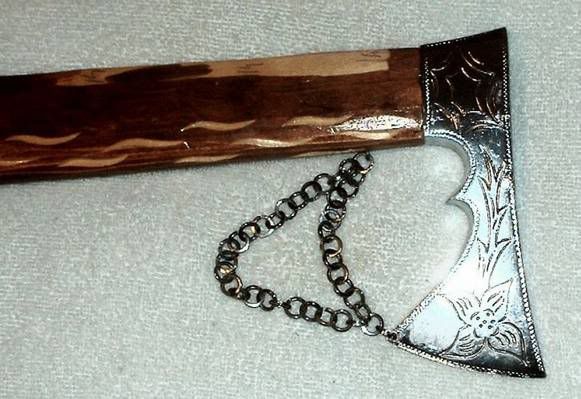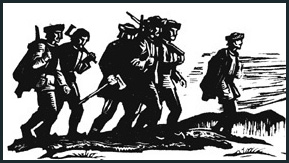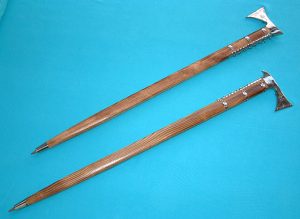On Saturday I rode to Witten to meet with Volker and to do some forging. Volker wasn´t too well, having problems with his hip bones and the rigors of blacksmithing for a long time. But he kept going nonetheless. I wish him all the best and hope he´ll be well.
We had a coffee, and I took a stroll around the museum to give you some input on the Ciupaga / Fokos / Sokyra / Bartka / Steigerstock / Fahrstock. Here is a pic of some miner in traditional representation attire and an unusual example of a Fahrstock, in that it has a hammer´s head!
A pick was also in use, as shown in this painting.
Here it is a hammer´s head again. This is an attire in use in the Witten / Bochum region.
Then I lit up forge and made myself "Her Grace Sokyra". C 60, forged from an old hammerhead, tempered selectively to a springy temper.
After that, I brought out the Borax, some mild steel and 1.2842 and simply got on with making damascus. I was focused hard, so nop pics of the process, but I´ve got an advice: If you want to get started with making damascus, try out this combination of steels, it welds great. Farther down you´ll read another little rant you all love on fancy steels and steel sorcery;-).
The billet with the tip already forged. I forged 27 layers, then turned it on the other side to achieve a "Masame" pattern, and welded another layer of 1.2842 into the middle. With so few layers, you get little carbon diffusion, so you might end up having a layer with too little carbon content to achieve a decent temper, so you´d better do a San Mai construction. I forged it into a straight back utility blade. I love the Roselli knives, but hate the short tang;-), so I forged a longer one to be peened over. The hindmost half of the tang is made from the billet handle, and it´s mild steel.
The blade.
Every time I realized my concentration was fading, I had a break. I took a drink of water, had a coffee with Volker (Thanks to the guy for providing a steady flow of Java;-)), and all went well.
Then there was a torch hike scheduled and I did a damascus demo for the people, and even got some applause!
The fruits of my labour;-).
At home I fitted a stag antler handle with brass mountings to it, and I tested it. Hard.
And it does what my spring steel knives do, with a lateral flexibility of some 20 degrees (fixed it in a vice and bent it), springy. I slammed it edge first on the tempered axle of my vice by accident. There was a dent, but a flexible one, that could be removed with some strokes of the strop. You can´t ask for more from a knife! In fact, it´s already more than most people would ever ask from a knife...
So, here´s the promised rant: Mild steel and 1.2842 certainly are no wonder steels. Few if any damascus smiths bother to use those qualities, and I admit I was sceptical at first when I learnt from
Jens Nettlich that he uses them. But it´s a bit like using spring steel. Many steel wizerds sneer at this common man´s steel, but what counts to me is that it works, and works well. The combination is a cinch to weld, even with dirty coke and a less-than-optimal forge, it was so easy I could not believe it! The knife keeps a good edge, is flexible to boot, and takes a hardness (at the edge) of 60 HRC with a very conservative heat treating. It also sharpens well and the edge is flexible to be stropped to new from a severe beating.
I made the spine some 3.8 mm thick.
This is a detail in riverso...
...and on the quart side.
I hope that I can practice these skills some more, to be able to process iron ore one day. Of course, I will also try to weld some more problematic steels, but as a user, this combination is hard to beat. I really, really love this knife, having used it some on bacon and wood;-) and iron nails and rawhide. It will become my personal EDC.
 http://guculiya.com.ua/en/hutsul-axes/211--.html
http://guculiya.com.ua/en/hutsul-axes/211--.html
![Die Nackenkammaxt aus dem Hort von Naumburg Gesamtansicht [Landesmuseum für Vorgeschichte Halle]](http://www.museum-digital.de/san/images/201108/29130358843.jpg)
![Die Schafthalsaxt von Freyburg OT Zscheiplitz [31]](http://www.museum-digital.de/san/images/201112/05094722444.jpg)
![Die Schafthalsaxt von Brachwitz Gesamtansicht [31]](http://www.museum-digital.de/san/images/201108/27161508871.jpg)

























